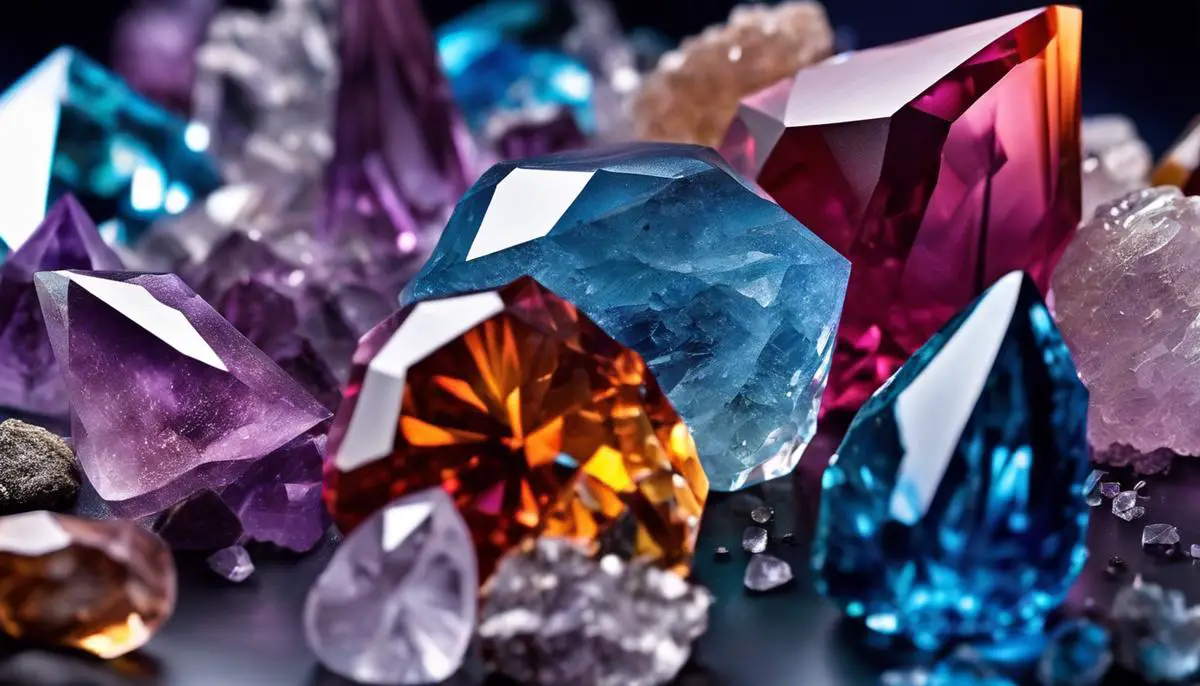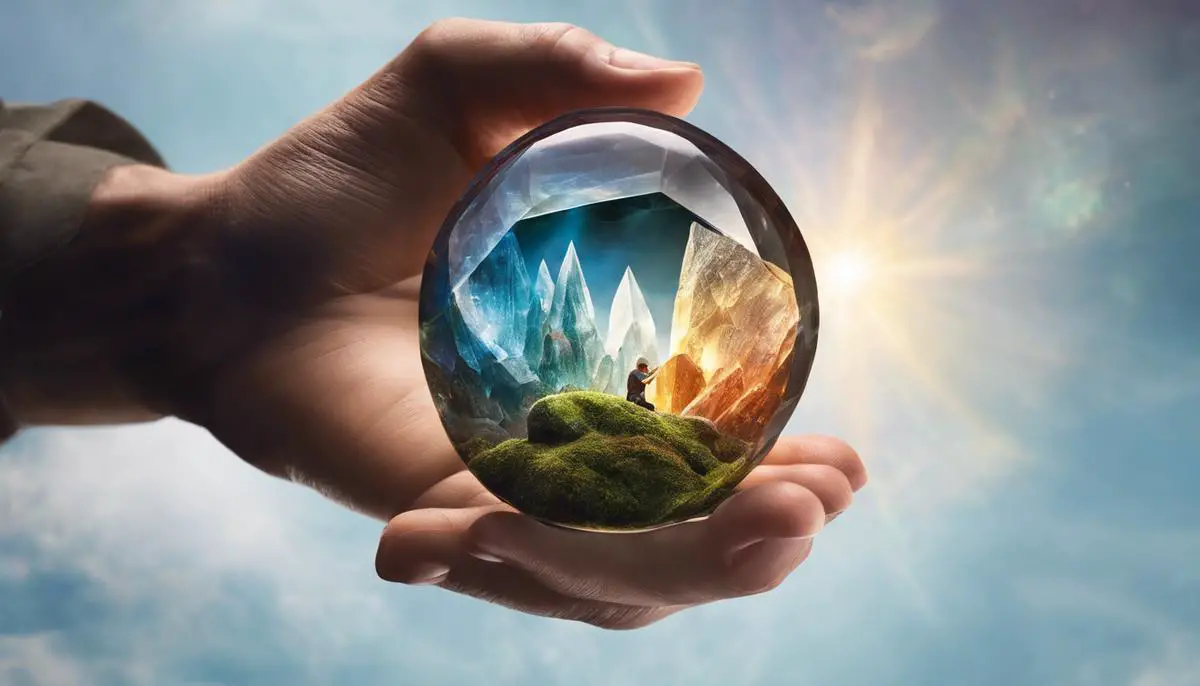Crystal healing, a practice as timeless as the shimmering minerals themselves, carries a rich tapestry of stories and beliefs that span the globe and bridge cultures. This essay illuminates the journey from ancient civilizations to contemporary society, revealing a fascinating chronicle where stones are more than mere adornments—they are venerated healers. We embark on a voyage through the history and principles of crystal healing, tracing the resonance of these gems from their primordial beginnings to the elaborate practices they inspire today. As we delve into the energetic dance between crystals and the human body’s chakras, we unfurl the wisdom of ages, embracing the colors and shapes that comprise the mosaic of crystal properties and their place in the healing arts.
History and Principles of Crystal Healing
Ancient Beginnings
Crystal healing has its roots stretching back thousands of years, with evidence of its use found in the ancient civilizations of Egypt, Greece, and Sumer. The Egyptians adorned themselves with crystals like turquoise and lapis lazuli for protection and health, while the Greeks allotted specific healing properties to various stones—Hematite was associated with Ares, the god of war, for its supposed ability to strengthen soldiers in battle. Throughout these ancient cultures, crystals were not merely decorative; they were central to spiritual practices and physical well-being, integrated into amulets, burial rites, and healing rituals, implying a deep connection to the earth and its energies.
Evolution and Spread
As trade routes expanded, so did the exchange of cultural practices, including crystal healing. By the Middle Ages, the knowledge of crystals and their properties had spread across Europe, and manuscripts detailing their medicinal uses became more widespread. During the Renaissance, a renewed interest in the writings of ancient philosophers such as Aristotle and Plato brought about a reinvigoration of crystal lore, with intellectuals of the era delving into the metaphysical properties of stones. However, the scientific revolution and the age of enlightenment shifted the focus towards empirical evidence and away from traditional crystal healing practices, relegating them to the realm of folklore and mysticism in the Western world.
Chakras and Energy Fields
The resurgence of crystal healing in the modern era is intertwined with the broader New Age movement, which looks towards Eastern traditions such as the concept of chakras—the energy centers of the body. According to these traditions, crystals interact with the human energy field or aura, helping to align and balance the chakras. Each of the seven main chakras correlates with specific areas of the body and aspects of emotional and spiritual well-being. For instance, amethyst is often used for the crown chakra to enhance spiritual connection and intuition, whereas green stones like jade or malachite are associated with the heart chakra, intended to foster love and compassion.
-

Celestial Soul Eco-Friendly Tote Bag
$18.50 Select options This product has multiple variants. The options may be chosen on the product page -

Celestial Soul Women’s T-Shirt
$20.00 – $21.50 Select options This product has multiple variants. The options may be chosen on the product page
Types of Crystals and Their Uses
Different crystals are believed to offer distinct healing properties. Clear quartz, known as the “master healer,” is thought to amplify energy and thoughts, as well as the effects of other crystals. Rose quartz is the quintessential stone of love, associated with emotional healing and the release of stress. Black tourmaline and smoky quartz are often turned to for protection and grounding, reputed to shield against negative energies. Carnelian, a vibrant orange stone, is heralded for stimulating motivation and creativity. Beyond individual properties, the shape, color, and composition of the crystals contribute to the perceived efficacy in the healing practice.
Cultural Significance Around the Globe
While crystal healing might be more commonly associated with New Age spirituality in the West, its presence is felt worldwide, permeating various cultures and traditions. In Traditional Chinese Medicine (TCM), crystals like jade are considered to carry life-enhancing energies. Native American cultures use crystals in healing ceremonies, and often turquoise is honored for its power of protection and connection to the spirit world. In India, Ayurvedic medicine incorporates gemstones in remedies, based on the belief that they can help to balance one’s doshas (body energies).
Modern Adoption and Criticism
In recent years, crystal healing has experienced a resurgence in mainstream culture, propelled by celebrity endorsements and an increased interest in alternative therapies. Yet, it remains a subject of considerable debate within the scientific community, which often insists on observable, repeatable evidence when evaluating such practices. Skeptics maintain that the perceived benefits of crystal healing can be chalked up to placebo effects, rather than any special attributes the crystals may hold. Despite the absence of scientific backing, the practice thrives within holistic care circles, with numerous adherents attesting to profound benefits to their mental and physical wellbeing. Hobbyists and enthusiasts are invited to explore and form their own conclusions, but should remain aware of the practice’s unproven status within the scientific realm.

Types of Crystals and Their Properties
Types of Crystals
The world of crystals is rich and varied, encompassing a wide variety of specimens each with their own unique colors, forms, and purported energetic qualities. Take quartz, for example—a highly adaptable crystal known for its power to boost energy and intent. Its different forms include clear quartz, which is said to increase mental clarity; rose quartz, associated with fostering love and emotional welfare; and smoky quartz, believed to offer stability and defensive energies.
Amethyst, prized for its tranquil violet shade, is lauded for its soothing effects on the psyche and its protective qualities. It is a common companion in meditation and is thought to aid in surmounting addictive behaviors. Citrine radiates positivity, akin to sunlight, and is touted for its potential to draw in prosperity, vibrancy, and healing, all the while purifying and rejuvenating.
For those looking to stay grounded and balanced, black tourmaline and hematite are favored choices, recognized for their capacity to safeguard the wearer. Lapis lazuli, with its deep azure studded with pyrite, is synonymous with the pursuit of wisdom and truth, often used to sharpen intellectual prowess and ignite a quest for knowledge.
Shapes and Forms
The shape of a crystal is just as significant as its type. Tumbled stones, with their polished, smooth surface, are convenient for carrying in a pocket or using in crystal grids. Raw or natural point crystals are often favored for directing energy in healing layouts or meditation practices, while spheres can emit energy evenly in all directions, creating a balanced atmosphere.
Pyramids, due to their geometric shape, are believed to focus energy through their apex, making them powerful tools for manifestation intentions. Similarly, wands or towers can direct energy more precisely and are often used in healing sessions to channel energy and target specific body areas or chakras.
Selecting Crystals for Healing
When selecting crystals, many enthusiasts trust their intuition, allowing the stones to choose them—often, the crystal that you’re most drawn to is the one that resonates best with your current energetic needs. It’s also important to consider the chakra or area you wish to work on. For example, green stones like malachite or aventurine are often associated with the heart chakra, hence potentially facilitating emotional healing.
Physical attributes like color and opacity may influence your choice. Transparent crystals are generally linked with clarity and consciousness, while opaque stones may offer a denser, more grounding energy.
Purported Healing Benefits
Crystals are believed to interact with the human energy field or aura, and can supposedly aid in the healing of physical, emotional, or spiritual issues. Practices may involve placing stones on the chakras or specific parts of the body, meditating with crystals, or simply having them in one’s environment.
Red crystals, like jasper or garnet, are often associated with the root chakra and are said to boost vitality and courage. Yellow stones such as tiger’s eye may enhance personal power and help with digestive issues, aligning with the solar plexus chakra.
Blue stones, matching the throat chakra, like aquamarine or sodalite, might be used to improve communication. Purple stones correspond with the third eye and crown chakras, with claims that they enhance intuition and spiritual connections.
Care and Maintenance
To maintain their energetic qualities, crystals require regular care. Cleansing them is crucial, as they’re believed to absorb and store the energies they come into contact with. Common methods include smudging with sage or palo santo, burying in the earth, cleansing with water, or clearing with sound like a singing bowl.
Charging crystals in sunlight or moonlight can be done to replenish their vitality, but be wary that some crystals can fade in direct sunlight. Additionally, certain crystals, like selenite or kyanite, are self-cleansing and can even be used to cleanse other stones.
Storing crystals in a way that they do not touch each other is often recommended to prevent them from absorbing each other’s energies. Silk, velvet, or natural containers like wooden boxes can also protect them energetically.
Embracing the Journey of Crystal Healing
As you delve into the world of crystal healing, knowing how to choose and care for your crystals becomes crucial. Each crystal is endowed with its own unique vibration that can resonate with your personal energy field, leading to growth in various aspects of your life. Through the thoughtful selection and dedicated nurturing of these minerals, a deeply personal bond is formed, offering a pathway towards enhanced well-being and a profound exploration of holistic practices.

Techniques and Application of Crystal Healing
Understanding Crystal Properties and Selection
The first step on this journey involves gaining a solid understanding of the myriad types of crystals and the distinctive properties they hold. Crystals like amethyst, with its tranquil vibrations, aid in alleviating stress while rose quartz is heralded for its ability to enrich relationships with its loving energy. The key to tapping into the potential of these natural gems is alignment with your individual needs and intentions.
When it comes to selecting the right crystal for you, allow your instincts to lead the way. As you hold a crystal, be mindful of the sensations or emotions it evokes. You may experience a certain warmth, a gentle pulsating, or an inexplicable attraction to one stone over another. These intuitive experiences are your internal guideposts, ensuring that the crystal you choose is one that truly harmonizes with your unique vibrational essence.
Cleansing Your Crystals
Before using crystals for healing, they should be cleansed of any previous energy they might have absorbed. There are several methods for cleansing, including smudging with sage, palo santo, or sweetgrass; using sound vibrations from bells or singing bowls; or placing them in moonlight, especially during a full moon. Rinse the crystals with water or bury them in the earth for a full reset. Remember to cleanse your crystals regularly, especially after intense healing sessions or if they’ve been in contact with negative energy.
Basic Crystal Placement
A fundamental practice is placing crystals on specific parts of the body, which are known as chakras or energy centers. There are seven main chakras, each associated with different physical and emotional aspects. Starting from the base of the spine to the crown of the head, you can place a crystal correlating to each chakra’s color and function. For instance, a red jasper might be placed at the base, or root chakra, for grounding, while a clear quartz could be placed at the crown chakra for spiritual connection.
Crystal Healing Layouts
There are various layouts and arrangements that can be used for healing. The simplest layout is placing a single crystal over the heart or any area in need of attention. More complex layouts include the “crystal grid,” where multiple stones are arranged in geometric patterns that amplify their collective energy. To create your grid, select a central stone, which will act as the anchor (often a larger or particularly resonant crystal), and surround it with complementary stones in a symmetrical pattern. Activate the grid by linking the energy of each stone with a wand or a pointed crystal, visualizing a bright light connecting them all.
Meditation with Crystals
Holding a crystal or placing it in front of you while meditating can deepen your practice. Each breath can draw in the energy of the crystal, helping to calm the mind and attune to the crystal’s frequency. Visualize the healing properties of the stone permeating your body and aura, releasing blockages and aligning your chakras.
Crystal Elixirs
Creating a crystal elixir is another practice for harnessing crystal energy, where the essence of the crystal is infused into water. Place a cleansed crystal in a glass of water and leave it in sunlight or moonlight for several hours. The water absorbs the crystal’s vibrations, which you can drink or use to anoint yourself or your space. Ensure that the crystal used is non-toxic and safe for immersion in water.
Safety Precautions
While crystal healing can be a powerful aid, it’s essential to approach it as a complementary practice, not a substitute for professional medical advice. Always use non-toxic, smooth stones to avoid ingestion or injury. If you’re placing crystals directly on the skin, make sure they are clean and placed gently.
Embracing crystal healing can become a transformative aspect of your daily wellness routine. As you delve into this practice, it’s crucial to find the techniques that resonate with you and enhance your personal energy. Your intention plays a critical role in this journey, serving as the driving force behind the healing process. Hold your chosen crystals with a clear focus on the positive transformations you aim to achieve, allowing them to support you in manifesting greater well-being.

Scientific Perspective and Ethical Considerations
Understanding Skepticism and Evaluating Scientific Perspectives
The conversation around crystal healing often includes a discussion on the balance between anecdotal success stories and scientific scrutiny. While numerous individuals report enhanced well-being as a result of crystal healing, the broader scientific community approaches these claims with caution, typically viewing the effects as no more substantial than those of a placebo. However, it’s worth noting the well-documented impact of the placebo effect—belief alone can significantly influence one’s feeling of improvement, which might explain the perceived benefits of crystals for some practitioners.
In scientific investigations, the measurable outcomes of crystal healing remain elusive, with many studies suggesting that any perceived effects could be due to the relaxation and meditative state achieved during the practice, rather than the crystals themselves. Experiments with control groups often reveal no significant divergence in response between participants holding genuine crystals and those with imitations, suggesting that without the power of suggestion, the crystals may not hold discernible healing properties.
Expert Opinions
Experts in fields such as psychology and medicine often view crystal healing with caution. Without dismissing the experiences people claim to have, they encourage a balanced view where crystal healing is not used as a substitute for professional medical advice or treatment. Medical professionals urge individuals to seek standard medical care for health issues, considering practices like crystal healing as complementary at best, rather than alternative therapies.
Ethical Considerations
As the popularity of crystal healing grows, concerns about the ethical sourcing of crystals become more pronounced. It’s no secret that mining practices can often be unsustainable and harmful to the environment, and in some cases, to communities in the vicinity of the mines. Issues such as child labor, exploitation, and environmental degradation are associated with some mining operations for popular healing crystals like quartz, amethyst, and others.
Practitioners of crystal healing who are environmentally and ethically conscious might opt for crystals that are sourced sustainably and ethically. These practices include ensuring fair wages and safe working conditions for miners, using minimal impact mining techniques, and avoiding areas where mining contributes to environmental destruction.
Sustainable Practices
For crystal healing enthusiasts concerned about sustainability, some might choose to reduce their impact by reusing, recycling, or sharing crystals instead of constantly purchasing new ones. They can also be mindful of the energy used in the production and transportation of crystals and try to purchase from local or small-scale miners where possible.
Respecting Origins
True respect for the power of crystals also means recognizing and honoring their origins. This includes acknowledging the land where the crystals were mined and the cultural significance they might hold for indigenous peoples. Some crystals are considered sacred by the local populations who have lived alongside them for centuries, and their removal can be seen as a form of cultural disrespect or appropriation.
Understanding the history and cultural context of crystals is essential in ensuring that crystal healing practices do not inadvertently contribute to the exploitation of resources that should otherwise be protected and revered. Enthusiasts may decide to educate themselves about the cultural heritage of the crystals they use and to support initiatives that protect both the environment and indigenous rights.
Conclusions
While the scientific community remains skeptical about the physical healing properties of crystals, enthusiasts may still find personal value and spiritual comfort in their use. However, balancing these practices with responsible sourcing and sustainability, as well as respecting the cultural origins of these precious resources, adds an ethical dimension to the pursuit of crystal healing. It’s essential for hobbyists to remain aware of the environmental and social impacts their choices have in the global context of crystal use.

The kaleidoscope of perspectives surrounding crystal healing invites us to ponder with an open yet discerning mind. While the scientific community continues to explore and challenge the fundamentals of this practice, the beauty and allure of these natural wonders remain undiminished. As practitioners and admirers alike, we are tasked with ensuring that our engagement with crystal healing not only nurtures the self but honors the sanctity of the earth. Through responsible stewardship and a heartfelt appreciation for the silent language of stones, we sustain the legacy of healing that is as enduring as the crystals themselves, echoing through time and space, urging us toward balance and wholeness.

